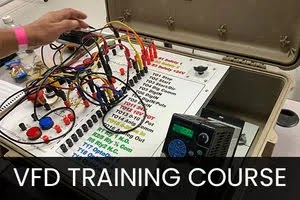Variable frequency drive (VFD)-BES
To use a rectifier, ac must be converted to dc or direct current. The rectifier energy is stored in an intermediate circuit, which maintains the voltage across the inverter. Capacitors in a DC circuit smooth the residual AC ripple and provide a constant DC voltage. The switching transistors of the inverter take this direct current and convert it into alternating current, which is then transmitted to the motor. A variable frequency drive can adjust the output frequency by rapidly switching between transistors coupled to a positive and negative DC bus. Burraq Engineering solutions provide the best online and Physical VFD Training in Lahore. Pulse width modulation allows the output voltage of the frequency converter to be adjusted by pulsing the DC voltage at a set frequency (PWM).
Variable frequency drive (VFD)
The
parameters of each converter are changed by the use of control circuits. It
comprises a microprocessor unit that controls the motor's speed, monitors the
AC inverter's signals and faults, and connects the inverter to other devices
via a communication protocol, among other things. The variable frequency drive
(VFD) helps the electric motor get up to speed and slow down quickly enough.
The terms "acceleration time" and "deceleration time"
describe these intervals. By changing the frequency at which power is delivered
to the AC motor, the variable frequency drive may regulate its rotational
speed.
AC and DC Inverters
The inverter
maintains a reasonably consistent voltage-to-frequency ratio (V/Hz) necessary
for the AC motor to provide the correct torque based on its specifications.
Let's look at the four major components of an AC converter—the rectifier, the
DC circuit, the inverter, and the control circuit—to get a feel for how an
AC/DC converter or VVVF operates. This device does just that, transforming the
AC electricity from the grid into the DC power that electronics may use.
Depending on the application, such as using a four-quadrant motor, this portion
can be unidirectional or bidirectional. It uses electronic switching components
like diodes, SCRs, transistors, and more.
VFD Communication
protocol
Capacitors
and chokes for DC storage and ripple damping are located here. The DC bus'
primary role is to collect, store, and distribute the DC generated by the
rectifier. Many electronic switches, such as transistors, thermistors, IGBTs,
etc., can be found in this area. To power the motor, it takes DC power from the
DC bus and transforms it into AC power. The inverter's settings, fault
circumstances, and interface communication protocols are all managed by a
microprocessor unit in the control circuit. To regulate the motor's rotational
velocity, it takes a reference speed signal from the engine and modifies the
voltage-frequency ratio correspondingly.
Variable torque
It is possible to cut energy consumption by adjusting the speed of motor-driven equipment to match the load requirements using a variable frequency drive (VFD) when the application does not require a whole-speed operation. Pumps, fans, compressors, and variable frequency drives (VFDs) can all benefit greatly from their ability to reduce energy use. For fans and pumps with variable torque, energy savings are more pronounced when torque and load power are square and cube of speed. In contrast to an AC motor, which starts under a higher mechanical shock load for both the motor and the mechanically linked gear, the VFD starts at zero speed and accelerates gradually.
Benefits of VFD
The unit's
durability decreases due to repeated impacts from this source of stress.
Conveyors, for instance, benefit considerably from a gradual startup and power
increase rather than a rapid burst of total power in applications where items
are quickly turned over, such as bottling lines. Limits on speed and torque
that can be adjusted are a massive boon to manufacturing operations. Variable
frequency drives (VFDs) enable a PC or process controller for remote speed
regulation. In addition, machines can be safeguarded thanks to the ability to
regulate and manage working torque precisely.
Electro-Thermal
When
calculating kW/KVA, the power factor is the ratio (active power to apparent
power). Under full load, the power factor of most standard AC motors is between
0.75 and 0.80. As the motor's load decreases, the power factor also drops. The
DC bus of a variable frequency drive (VFD) includes capacitors that keep the
power factor on the line side of the frequency converter high. Because of this,
you won't have to spend money on more batteries or capacitors. Starting a load
using a variable frequency drive (VFD) shields the motor or gear from damaging "shocks"
at startup and issues like electrothermal overload, phase protection, under
voltage, overvoltage, and so on. It's this

.jpg)


Comments
Post a Comment